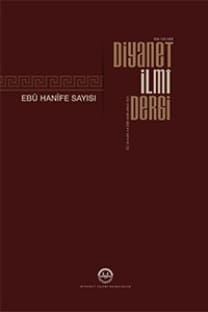MÂLİKÎ MEZHEBİNDE MEZHEP İÇİ İHTİLÂF
Fıkıh, Mâlikî Mezhebi, İhtilâf, Mezhep İçi İhtilâf
INTRA-SECT CONFLİCT İN THE MALİKİ SCHOOL
Fiqh, Maliki School, conflict, intra-sect conflict,
___
- Cîdî, Ömer. Mebâhisun fi’l-mezhebi’l-Mâlikî bi’l-Mağrib. Yy: Dâru neşr, 1993.
- Cübeyrî, Kāsım b. Halef. et-Tavassut beyne Mâlik ve İbnKâsım fi’lmesâil elletî ihtelefâ fihâ min mesâili Müdevvene. Nşr. Ebû Süfyân Mustafâ Bâcû. Tantâ: Dârü’d-dıyâ’, 1426/2005.
- Çavuşoğlu, Ali Hakan. Irak Mâlikî Ekolü (III.-V./ IX.-XI. Yy.). Doktora Tezi. Marmara Üniversitesi. 2004. Çavuşoğlu, Ali Hakan. “Endülüs’te Rey-Hadîs Mücadelesi”. İslâmiyât. 3 (2004): 59-74.
- Çavuşoğlu, Ali Hakan. “el-Müdevvenetü’l-Kübrâ”. Türkiye Diyanet Vakfı İslâm Ansiklopedisi. 31: 470-73. Ankara: TDV Yayınları, 2006.
- Çavuşoğlu, Ali Hakan. “en-Nevâdir ve’z-ziyâdât”. Türkiye Diyanet Vakfı İslâm Ansiklopedisi. 33: 30-33. Ankara: TDV Yayınları, 2007.
- Debûsî, Ebû Zeyd Abdullah b. Ömer b. Îsâ. Kitâbu Te’sîsi’n-Nazar. Mısır: Matbaatu’l-Arabiyye, t.y.
- Dusûkî. Hâşiyetu’d-Dusûkî ‘alâ’ş-şerhi’l-kebîr. Nşr. Muhammed ‘Illîş. Beyrût: Dârü’l-‘ıhyâi’l-kütübi’l-‘arabiyye, ty..
- Ebu’l-Ecfân, Muhammed el-Hâdî. “İbn Şâs”. Türkiye Diyanet Vakfı İslâm Ansiklopedisi. 20: 369.Ankara: TDV Yayınları, 1999.
- Fehîm, ‘Acrîd. el-Mesâilü’l-fıkhiyye el-muhtelif fî teşhîrihâ fi’l-Mezhebi’l-Mâlikî. Doktora Tezi. Cezâir Üniversitesi. 2012.
- Görgün, Tahsin. “İbn Habîb es-Sülemî”, Türkiye Diyanet Vakfı İslâm Ansiklopedisi. 19: 510-513. Ankara: TDV Yayınları, 2003.
- Hacvî, Muhammed b. Hasan. el-Fikru’s-sâmî fî târihi’l-fıkhi’l-İslâmî. 4 cilt. Mağrib: el-Matba‘atu’l-belediyye, 1345.
- Halîfî, ‘Abdulazîz b. Sâlih. el-İhtilâfu’l-fıkhî fi’l-mezhebi’l-Mâlikî mustalahâtuhu ve esbâbuhu. Mağrib:Dârü’l-hadîsi’l-haseniyye, 1414/1993.
- Hentâtî, Necmuddîn. el-mezhebu’l-Mâlikî bi’l-gārbi’l-islâmî ilâ muntasafi’l-karni’l-hâmis el-hicrî. Tûnus: Tebrü’z-zamân, 2004.
- İbn ‘Abdilberr, Ebû ‘Ömer Yûsuf en-Nemerî. el-İntikâ fî fedâili’l- eimmeti’s-selâseti’l-fukahâ. Nşr. A. Ebû Gūdde. Beyrût: Dârü’l-beşâiri’l-islâmiyye, 1417/1997.
- İbn ‘Abdilberr, Ebû ‘Ömer Yûsuf en-Nemerî. İhtilâfu ashabı Mâlik ve ashâbihî. Nşr. Hamîd Muhammed Lahmer, Miklos Muranyî. Beyrût: Dârü’l-gārbi’l-islâmî, 2003.
- İbnu’l-Cellâb, Ebu’l-Kâsım Ubeydullâh b. Huseyn b. Hasân. et-Tefrî‘. Nşr. Huseyn b. Sâlim. Cilt Beyrût: Dârü’l-gārbi’l-islâmî, 1997.
- İbn Ferhûn. Keşfu’n-nikâbi’l-hâcib min mustalah İbnu’l-Hâcib. Nşr. Hamza Ebû Fâris ve Abdüsselâm eş-Şerîf. Beyrut: Dârü’l-gārbi’l-İslâmî, 1990.
- İbn Ferhûn, Tabsiratu’l-hükkâm fî usuli’l-akdiyeti ve menâhici’l-ahkâm. Nşr. Cemâl Mar’aşlı. Riyâd: Dâru ‘âlemi’l-kütüb, 2003.
- İbn Serrâc. Fetâvâ Kādı’l-cemâ‘a Ebu’l-Kāsım b. Serrâc el-Endülüsî. Nşr. Muhammed Ebu’l-Ecfân. Mekke: Dârü’l-kütüb, 2002.
- İbrâhîm ‘Alî, Muhammed. Istılâhu’l-mezheb ‘ınde’l-Mâlikîyye. Dübey: Dârü’l-buhûs li’d-dirâsâti’l-islâmiyye ve ihyâi’t-turâs, 1421/2000.
- İsfehânî Ragıb Ebü›l-Kâsım. Mu‘cemu Müfredâti Elfâzi’l-Kur’ân. Nşr. Safvân Adnân Dâvûdî. Beyrût: Dârü’l-kalem-ed-Dârü’ş-şâmiyye, 1992.
- Kâdî ‘Iyâz, Tertîbu’l-medârik ve takrîbu’l-mesâlik li ma‘rifeti e‘lâmi mezhebi Mâlik. Nşr. Saîd Ahmed E‘râb. Rabât: Vizaretü’l-evkaf ve’ş-şu‘ûni’l-islâmiyye, 1403/1983.
- Kayravânî, İbn Ebî Zeyd. en-Nevâdir ve’z-ziyâdât ‘alâ mâ fi’l-Müdevveneti min ğayrihâ mine’l-ümmehâti. Nşr. Muhammed Haccî. 15 Cilt. Beyrût: 1999.
- Kaya, Eyüp Saîd. “Mâlikî Mezhebi”. Türkiye Diyanet Vakfı İslâm Ansiklopedisi. 27: 519-535. Ankara: TDV Yayınları, 2003.
- Kesgin, Hafsa. “Ebü’l-Hasan el-Lahmî ve Mâlikî Mezhebindeki Yeri”. İlahiyat Tetkikleri Dergisi, 50 (2018): 219-141.
- Kesgin, Hafsa. Mâlikî Fıkıh Geleneğinde Nevâzil: Endülüs Örneği. Doktora Tezi. Sakarya Üniversitesi. Aralık 2013.
- Koca, Ferhat. Mukayeseli İslâm Hukuk Düşüncesinin Temellendirilmesi. Ankara: Ankara Okulu Yayınları, 2009.
- Kılıçer, M.Esat. “Ehl-i Re’y”. Türkiye Diyanet Vakfı İslâm Ansiklopedisi. 10: 520-524. Ankara: TDV Yayınları, 1994.
- Mâlik b. Enes. Muvattâ’. 2 Cilt. Beyrut: Dârü ihyâü’t-türâsi’l-‘arabî, 1985/1406. Mâlik b. Enes. Muvatta’(Rivâyetu Yahyâ b. Yahyâ el-Leysî. 2 Cilt. Beyrut: Daru’l-gārbi’l-islâmî, 1997.
- Muranyî, Mikolas. Dirâsât fî masâdıri’l-fıkhi’l-Mâlikî. trc. Sa‘îd Buhayrî ve Diğerleri. Beyrût: Dâru’l-gārbi’l-islâmî, 1988.
- Öğüt, Salim. “Ebû Yûsuf”. Türkiye Diyanet Vakfı İslâm Ansiklopedisi. 10: 260-265. Ankara: TDV Yayınları, 1994.
- Özen, Şükrü. “İhtilâf”. Türkiye Diyanet Vakfı İslâm Ansiklopedisi. 21: 565-568. Ankara: TDV Yayınları, 1988.
- Özen, Şükrü. “Hilâf”. Türkiye Diyanet Vakfı İslâm Ansiklopedisi. 17: 527-538. Ankara: TDV Yayınları, 1988.
- Suyûtî, Ebu’l-Fazl Celâleddîn Abdurrahmân b. Ebî Bekr. Nazmü’l-‘ıkyân fî a‘yâni’l-a‘yân. Nşr. Phılıp Hıttı. Beyrut: el-Mektebetu’l-‘ılmiyye, ts.
- Şafak, Ali. İslâm Hukukunun Tedvîni. Erzurum: Atatürk Üniversitesi Yay., 1997.
- Şâtıbî, Mûsâ b. Muhammed. el-Muvafakât fî ‘usûli’l-ahkâm. Nşr. Abdullah Dıraz. 4 Cilt. Kâhire: Dârü’l-ma‘rife, ts.
- Taş, Aydın. “Şeybânî, Muhammed b. Hasan”. Türkiye Diyanet Vakfı İslâm Ansiklopedisi. 39: 38-42. Ankara: TDV Yayınları, 1994.
- Tusûlî, Ebu’l-Hasan. el-Behçe fî şerhi’t-Tuhfe. Nşr. Muhammed ‘Abdul-Kādîr Şâhîn. Beyrût: Dârü’l-kütübü’l- ‘ılmiyye, 1998.
- Venşerîsî, Ahmed b. Yahyâ. el-Mi‘yâru’l-mu’rîb ve’l-câm ‘u’l-Mağrib ‘an fetâvâ ehl-i Ifrîkiyye ve’l-Endelüs ve’l-Mağrib. Nşr. Muhammed Haccî. 13 Cilt. Beyrût: Dârü’l-gārbi’l-islâmî, 1401/1981.
- Yetkin, Hacer Kontbay. “İbn Lüb”. Türkiye Diyanet Vakfı İslâm Ansiklopedisi. Ek-1: 594-595. Ankara: TDV Yayınları, 2016.
- ISSN: 1300-8498
- Yayın Aralığı: 4
- Başlangıç: 1956
- Yayıncı: -
FIKIH USÛLÜNDE NÂSİH VE MENSUH OLMA YÖNÜNDEN İCMÂ
AYETLER ÇERÇEVESİNDE EZANIN MUHTEVASININ TAHLİLİ
MOLLA SADRÂ’DA VÂCİBÜ’L-VÜCÛD’UN İSPATINDA BURHAN-I SIDDIKÎN
ARŞİV VE MAHKEME KAYITLARINA GÖRE OSMANLI PAYİTAHTINDA YAŞLI OLMAK (16-18. YÜZYILLAR)
İSLÂM HUKUKUNDA SUÇ-CEZA DENGESİNİN ADALETLE İLİŞKİSİ
MÂLİKÎ MEZHEBİNDE MEZHEP İÇİ İHTİLÂF
İMAM MÂTÜRÎDÎ’DE AKIL, İNSANÎ DOĞA (TAB‘) ve FITRAT
